Xian Tours
Beijing Tours
China Tour Packages
About
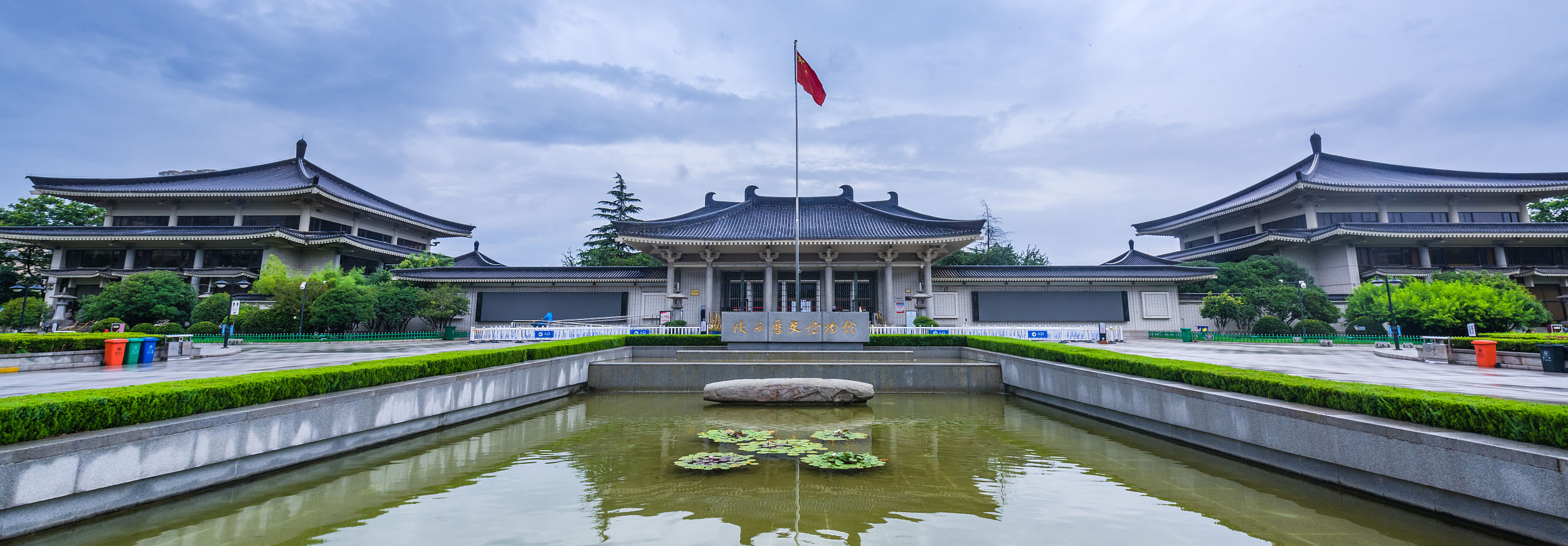
The Shaanxi History Museum is the grandest museum in Shaanxi Province. Due to Shaanxi’s long-time important position both in location and politics in ancient Chinese history, many people say that Shaanxi is a live history museum in China. 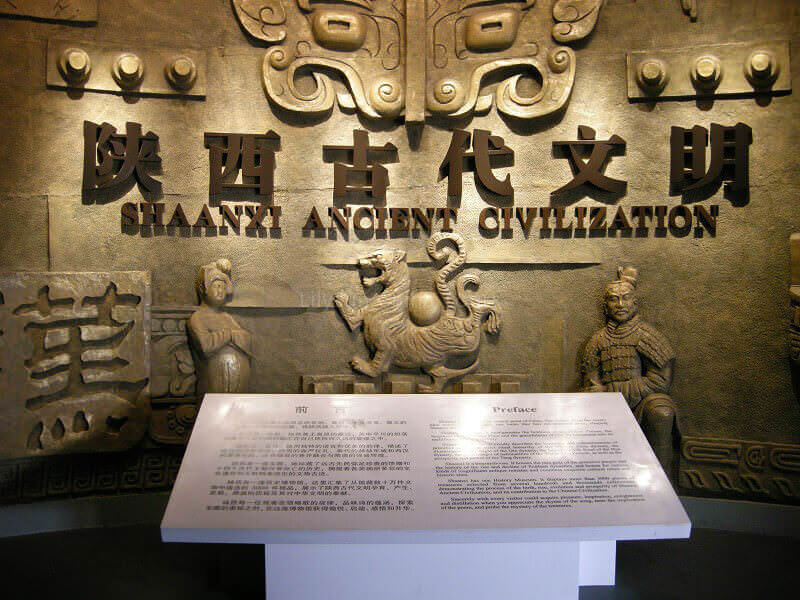 This is a massive modern museum of national standard and was opened to the public in June 1991. Located in the southern suburbs of Xian, the museum covers an area of 70,000 square meters and has a collection of over 113,000 historic and cultural relics.
This is a massive modern museum of national standard and was opened to the public in June 1991. Located in the southern suburbs of Xian, the museum covers an area of 70,000 square meters and has a collection of over 113,000 historic and cultural relics.
The museum is a magnificent architectural complex in the Tang Dynasty style. It combines the architectural style of the ancient Chinese palaces and courtyard buildings, making it look harmonious, graceful and imposing. The whole museum is divided into three galleries with close to 3,000 carefully chosen exhibits on display depicting the over one million years of history of Shaanxi and
Chinese Dynasties ranging from 1.15 million years ago to the eve of the Opium War in 1840.
The massive picture facing us shows the surging and roaring 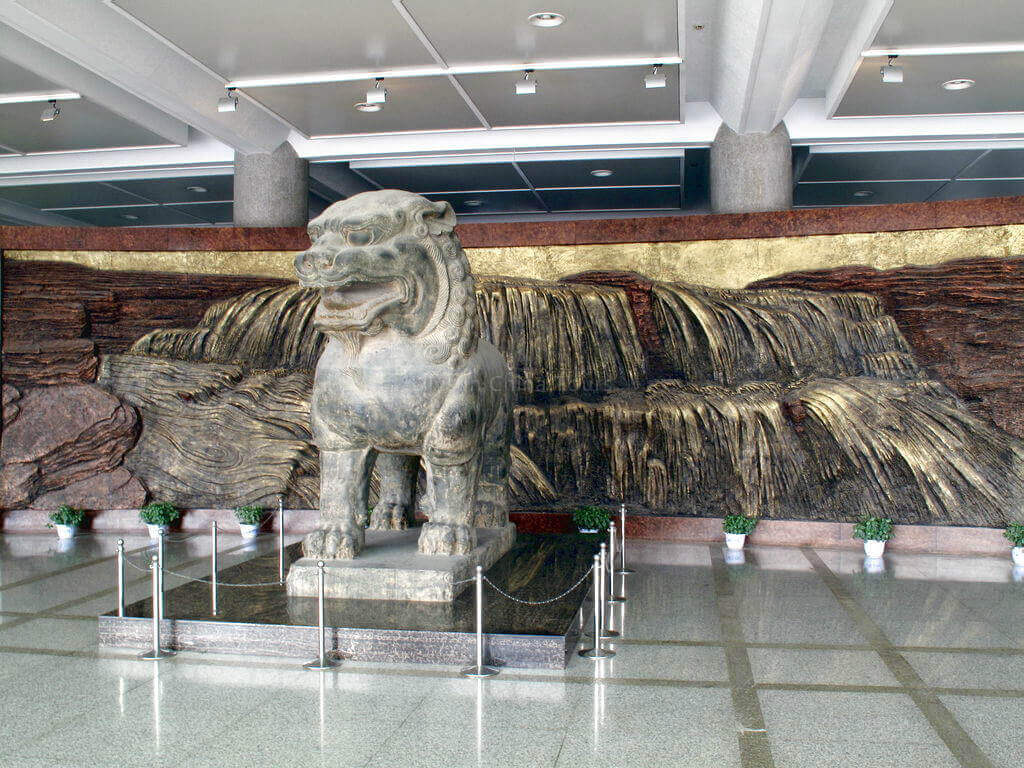 Yellow River and vast Loess Plateau. This is the natural habitat of the Shaanxi people and the cradle of Shaanxi’s ancient civilization.
Yellow River and vast Loess Plateau. This is the natural habitat of the Shaanxi people and the cradle of Shaanxi’s ancient civilization.
The giant stone lion comes from Shunling, the mausoleum of Empress Wu Zetian’s mother. Its exquisite craftsmanship and imposing look rank it the ‘number one lion in the orient’. Chinese stone lion techniques were from Afghanistan. The craftsman combined the romantic and colorful spirit of western carving and the profundity of Chinese carving together to make this lion, so it can be regarded as a product of the cultural exchange between the East and the West.
The first section focuses on the history of Shaanxi Province during the Prehistoric Age, which ranges from 1,150,000 years ago to the 21st century B.C. Shaanxi is an important source of information on the origin of the human race in Asia. It covers the entire span of time from the beginning of the Paleolithic Period to the end of Neolithic Period.
The most famous historic relic here is a rehabilitated head of an Ape-man using the fossil remains of an Ape-man’s skull.  The skull was discovered in 1964 in Lantian County, Shaanxi Province, so it is also called ‘Lantian Man’. According to the latest dating data, it lived 1.15 millions years ago and was the earliest known Homo Erectus in Asia. The implements on display were excavated from the county. They were made of stone and used by Lantian Ape-man for cooking, fighting and other daily tasks.
The skull was discovered in 1964 in Lantian County, Shaanxi Province, so it is also called ‘Lantian Man’. According to the latest dating data, it lived 1.15 millions years ago and was the earliest known Homo Erectus in Asia. The implements on display were excavated from the county. They were made of stone and used by Lantian Ape-man for cooking, fighting and other daily tasks.
There is a community model showing the home of people in the Yangshao Cultural period, which dates back some 6,000 to 7,000 years ago. It was a prosperous matrilineal society, in which women dominated the whole society. Children didn’t know their fathers, only knew their mothers. Most representatives of the Yangshao culture relics are the red painted pottery utensils such as the pottery steamer, tip-bottomed bottle and human-fish decorated basins.
Following the matrilineal society, humans moved into a period of a patriarchal clan society, where men started to dominate the whole society. The Longshan Culture is the most representative culture of this society. Here on display are exhibits of the relics of the Longshan culture sites. The main difference from the Yangshao Culture is the gray pottery which is more delicate and exquisite than the painted pottery. The Li, Ding and other steaming and boiling vessels, as well as beautiful drinking vessels can be seen . There are also some jade wares and other decorative wares on display.
The Zhou Period includes three different stages: the Zhou Clan, the Zhoufang State, 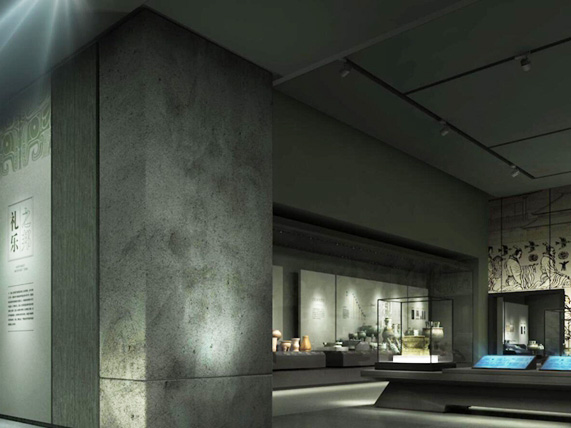 and the Western Zhou Dynasty. Several small tribes lived on the banks of the Jing and Wei rivers. During the late period of the Longshaan culture, these tribes formed the Zhou Clan. Here on display are cultural relics of the early Zhou Period.
and the Western Zhou Dynasty. Several small tribes lived on the banks of the Jing and Wei rivers. During the late period of the Longshaan culture, these tribes formed the Zhou Clan. Here on display are cultural relics of the early Zhou Period.
This oracle bone is a well-preserved scapula of an ox. The four tiny hollows you can see were cut by the ancient Chinese when they practiced divination. Divination had to be practiced at the time in preparation for all important events. The ancient people first cut hollows in tortoise-shells or animal bones, twisted mugwort into thread and applied burning thread to the hollows on the back. The diviner would interpret the cracks in the bones as auspicious, inauspicious or neutral. A record of the divination result was then cut into the tortoise-shells or animal bones, which formed China’s earliest written language known today as ‘inscriptions on tortoise-shells or animal bones’.
In the 16th century B.C, to avoid the nomadic tribe’s invasion, the Zhou clan settled down in the present Fufeng and Qishan counties. 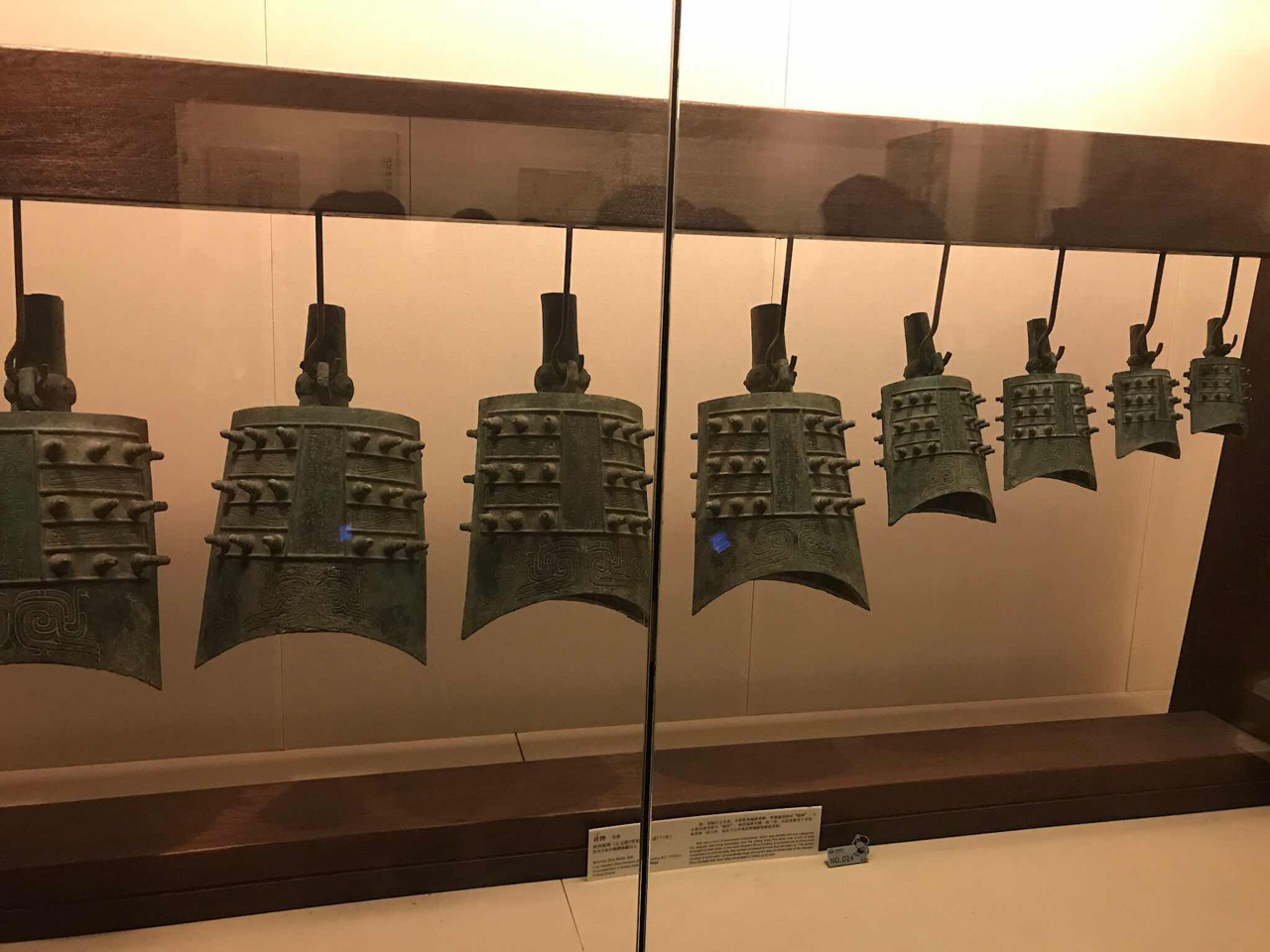 They established their capital and a government body there. It was then acknowledged by the Shang Dynasty as ‘Fang State’. In the 11th century B.C., the Shang Dynasty died and the Western Zhou Dynasty came into existence. The Zhou leaders established the capital in Feng and Hao, which were separated by the Feng River. This marked the emergence of the ancient city Xi’an.
They established their capital and a government body there. It was then acknowledged by the Shang Dynasty as ‘Fang State’. In the 11th century B.C., the Shang Dynasty died and the Western Zhou Dynasty came into existence. The Zhou leaders established the capital in Feng and Hao, which were separated by the Feng River. This marked the emergence of the ancient city Xi’an.
Bronze wares were well developed in the Western Zhou Dynasty. Here on display are exhibits of ceremonial and music instruments, implements for living and production as well as weapons for fighting. There are also typical traditional Chinese bronze vine vessels, bronze water containers, bronze mirrors, bronze tripods and plates. Most of them are national treasures.
The Qin period covers three historic periods: The Spring and Autumn, the Warring States, 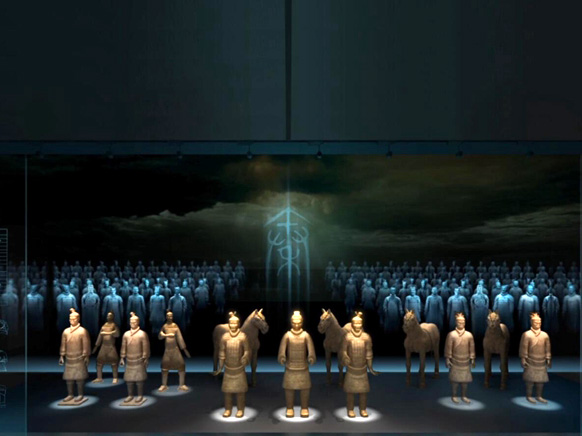 and the Qin Dynasty. The Qin was an ancient tribal clan that used to live in Tianshui--Gansu Province. The forefather of the first Qin emperor was called Xianggong. In 770 BC, King Ping of the Zhou Dynasty bestowed a favor upon Qin Xianggong and appointed him an imperial duke. Later, Qin Xianggong established Yongcheng as his own capital, which is presently Fengxiang county in Shaanxi Province.
and the Qin Dynasty. The Qin was an ancient tribal clan that used to live in Tianshui--Gansu Province. The forefather of the first Qin emperor was called Xianggong. In 770 BC, King Ping of the Zhou Dynasty bestowed a favor upon Qin Xianggong and appointed him an imperial duke. Later, Qin Xianggong established Yongcheng as his own capital, which is presently Fengxiang county in Shaanxi Province.
There is an outer coffin excavated in No.1 Tomb of the Duke of Qin. It is the largest excavation in China, 24 meters deep and with an area of 5.334 square meters. Altogether 166 people were buried alive with the dead. The tomb suffered many serious robberies, but even so, more than 3,500 various kinds of cultural relics have been unearthed.
In 350 BC, the Qin state moved to Xianyang. Within ten years, Emperor Qin had annexed all other six states and founded the first multi-national, autocratic and centralized feudal empire in Chinese history. Hence the Qin Dynasty was born.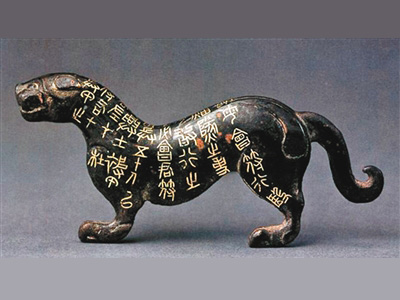
Here you will see many terracotta warriors, horses and weapons on display, representing the underground army for protecting Qin Shihuang after his death. They were discovered around Qin Shihuang’s mausoleum.
After unification, Emperor Qin Shihuang adopted a series of measures to enforce centralization. He standardized the coinage, weights and measurements, the legal codes, and the written scripts. To take coinage as example; you can see the six kinds of coinage used in the six states. The different coinage used by the states caused a great deal of trouble in calculation so Qin Shihuang standardized the coinage by introducing a round coin pierced with a square hole in the centre. This kind of coin was kept in use for the following 2,000 years.
The Han Dynasty was a very important historical stage in China’s history. The Han nationality was officially formed during this historical period. The Han exerted a far-reaching influence on the development of the succeeding dynasties in Chinese History. That is why “Han” is a synonym for Chinese people and civilization in the world today. The Han Dynasty chose Xi’an as their capital, located just northwest of the present day Xi’an. At that time it was called Chang’an, which means permanent peace. Here is a water container that was used at a famous palace called ShangLin Palace. That palace served as the imperial yard for hunting.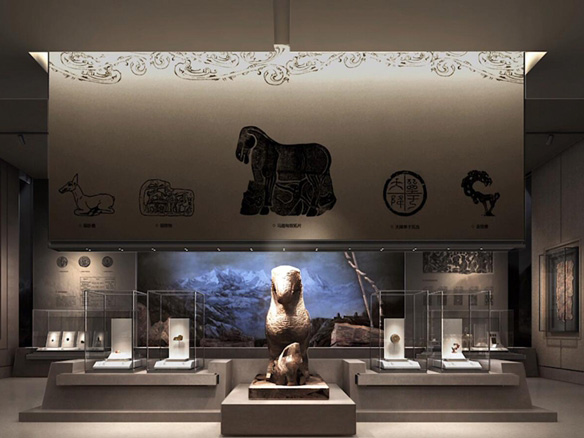
In this hall, you will see the most famous Han tiles, pottery animals, terra-cotta figures and also the map of the silk road which was opened in the Han Dynasty. Compared with the Qin tiles, the Han tiles are larger with wider edges, and are grayish in color. And many tiles are inscribed with characters of great calligraphic value. The Han terracotta figures are shorter and smaller than the Qin terracotta warriors. That is because at the beginning of the Han Dynasty, the economy was destroyed by constant war, so the entire nation endeavored to improve the economy.
These iron tools, water conservancy projects and farm cattle indicate that agriculture was well developed in the Han Dynasty. These pottery oxen, chicks, ducks, and pigsties are all burial objects excavated from Han tombs. You may be curious why such things were buried together with the dead people? Well, the Han people treated the dead as well as they treated the living. They thought the dead people just went to another world to change their living environment, so should be provided with all the daily necessities in their tombs.
There is an artistically exquisite and vividly shaped swan-goose-and-fish lamp which was unearthed in Shenmu County, Northern Shaanxi. It is in the shape of a swan goose turning its head to hold a fish in its bill. Between the bill and the body are two lamp shades which can open and close to shield wind or adjust the angle and brightness of the light. When the lamp is lit, its smoke will move through the neck of the swan goose into its water-filled body. 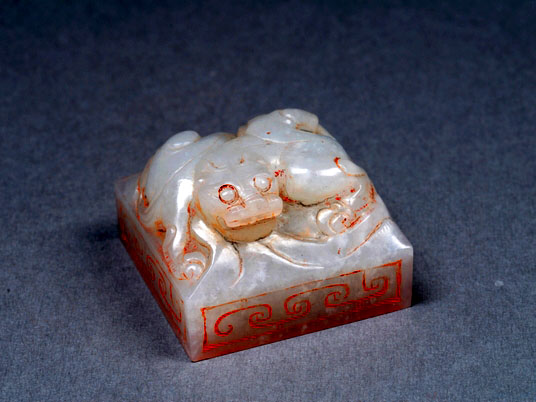 The smoke dissolves in the water to ensure purification of air. The four parts of the lamp can be dismantled and assembled freely, making the cleaning of dust and soot easy. The lamp is scientifically designed and uniquely shaped, and can be used for both decorative and practical purposes. It is fondly called an environmentally friendly lamp now.
The smoke dissolves in the water to ensure purification of air. The four parts of the lamp can be dismantled and assembled freely, making the cleaning of dust and soot easy. The lamp is scientifically designed and uniquely shaped, and can be used for both decorative and practical purposes. It is fondly called an environmentally friendly lamp now.
These seemingly insignificant fibre fragments are the world’s earliest paper made of plant fibre. This specimen was unearthed from a Western Han tomb at Baqiao, Xi’an in 1957. The paper fragments were no later than 118 BC, one century earlier than the paper invented by Cai Lun appeared.
The last thing you will see is the map of the Silk Road. It was formally opened in the Han Dynasty, by a famous official called Zhang Qian. He went across the Asian continent to establish good relationships with other countries. The road was from Chang’an to Persia, connecting middle Asia, southern Asia, western Asia, Europe and north Africa together. Through this road, Chinese silk and porcelain was spread to the world and in turn, horses of fine breeds, plants, music and dances were imported into China.. At that time, Chang’an, the present Xi’an, became the largest center in Asia for international exchange.
During this period a lot of wars took place , so many of dynasties co-existed at the same time. China experienced a long period of social upheaval with frequent wars during these 400 years. Shaanxi province experienced almost 10 different leaders, and as a result we can see a lot of artifacts with strong military influence.
Here you will see a a tomb gate whose owner was called An Jia, 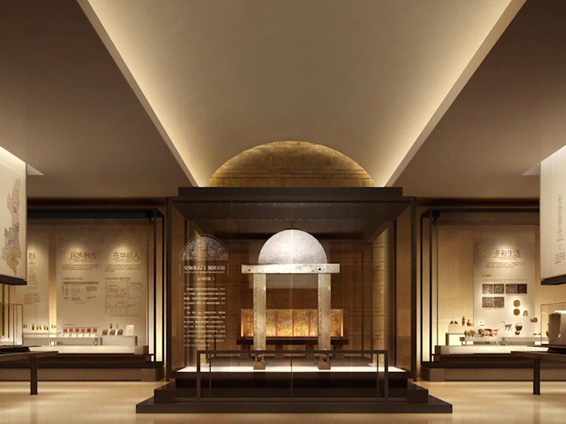 one of the earliest foreigners coming from the western regions to do business in China. He then stayed in China and became an official. His mother country no longer exists.. You can see his bed still kept in the western style and the 11 wall paintings reflect his social life at that time.
one of the earliest foreigners coming from the western regions to do business in China. He then stayed in China and became an official. His mother country no longer exists.. You can see his bed still kept in the western style and the 11 wall paintings reflect his social life at that time.
Many bronze weapons, warriors, and pottery ‘tomb-guarding’ animals are shown in this hall. Some of the most special exhibits are the many Buddhist statues. Because of the times of chaos , with people suffering unceasing war and upheaval, they wanted to seek relief from their heavy spiritual pressures. Buddhism was brought into China during that time, and quickly accepted by people. They made many Buddha statues to show their devotion. The Buddha statues are made of gold, silver, bronze and jade. The one made of iron is the most eye-catching. It is said to be modeled on Yang Jian, who was born in a Buddhist nunnery and became an emperor of the later Sui Dynasty.
The Sui and Tang Dynasties was a period when China’s feudal society was at the height of its power and splendor. 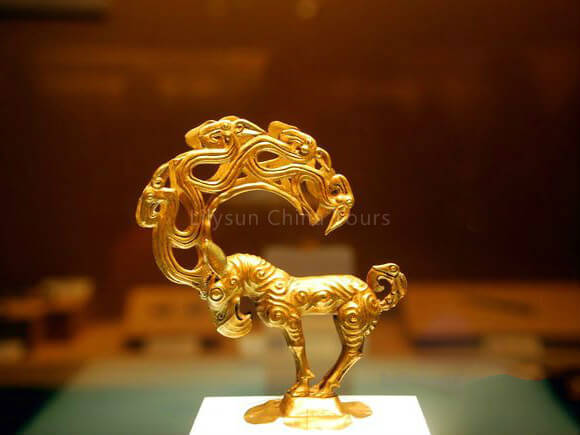 It also marked a golden era in the history of Shaanxi. Chinese residing overseas still regard themselves as the descendants of the Tang Dynasty. This, to some extent, reflects the enormous impact the Tang Dynasty has had on its descendants. This map shows the layout of Chang’an.
It also marked a golden era in the history of Shaanxi. Chinese residing overseas still regard themselves as the descendants of the Tang Dynasty. This, to some extent, reflects the enormous impact the Tang Dynasty has had on its descendants. This map shows the layout of Chang’an.
The Sui Dynasty, before the establishment of the Tang, was founded in 581 AD. It began to construct its capital Daxing in the following year. In the Tang Dynasty, the city’s name was changed into Chang’an. There is a model of Tang’s Chang’an city. It was built on the basis of the Sui Daxing city with further improvement and expansion. It was a well-planned city divided into three zones: the palace area, the administrative area, and the residential area. The city was crisscrossed with 11 vertical and 14 horizontal streets, dividing Chang’an into 108 rectangular compounds known as Fang. This layout of the city became the model for capital cities in many other Asian countries such as Japan and Korea. The Tang Chang’an City covered an area of 84.1 square kilometers, seven times the the size of Byzantium, the capital of the Eastern Roman Empire; six times the size of the Arabian capital of Baghdad, and 9.3 times larger than the Ming Xi’an city.
In contrast to the previous dynasties, the Tang featured its gold and silver utensils, 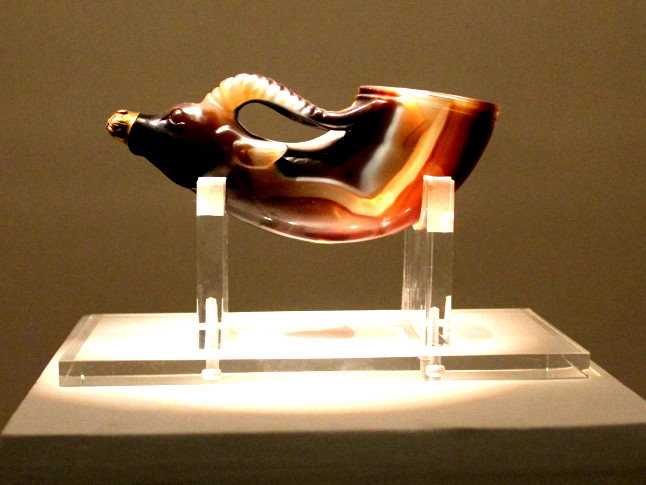 reflecting the thriving and abundant life of the Tang people. These exquisite gold and silver plates and vessels were mostly discovered at Hejiacun Village in the southern suburb of Xi’an in 1970. These gold and silver wares shown here were excavated from the Famen Temple in the Fufeng County. They include food and drink vessels, containers and medical tools.
reflecting the thriving and abundant life of the Tang people. These exquisite gold and silver plates and vessels were mostly discovered at Hejiacun Village in the southern suburb of Xi’an in 1970. These gold and silver wares shown here were excavated from the Famen Temple in the Fufeng County. They include food and drink vessels, containers and medical tools.
There are also some Tang tricolor ceramics that were all buried objects. It is well known that China was famed as a ‘nation of china’. Actually China’s porcelain art can be traced back to 3,000 years ago in the Shang Dynasty. The Tang dynasty produced the glazed pottery of brown, yellow and green colors. This craft prevailed only in a rather short period in limited areas, so the small number of tricolor pottery is of priceless value today.
Because the Tang people led a relatively long peaceful life, they enjoyed more leisure and entertainment. 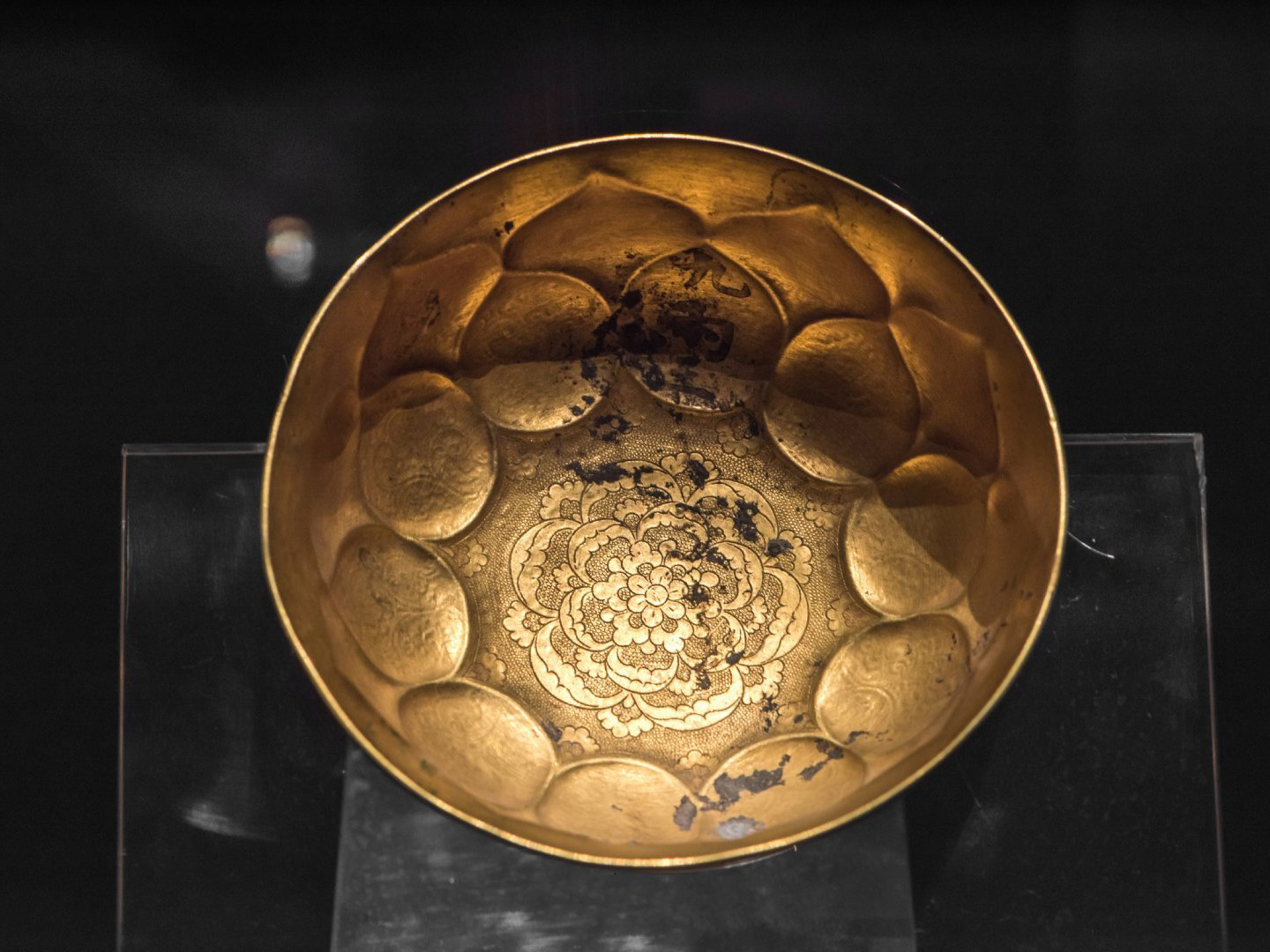 Hunting, polo, swing, tug-of-war, acrobatics, music and dance became very popular. You can see it from these mural paintings and also the exhibition of pottery dancing figures and the board of the game of ‘Go’.
Hunting, polo, swing, tug-of-war, acrobatics, music and dance became very popular. You can see it from these mural paintings and also the exhibition of pottery dancing figures and the board of the game of ‘Go’.
There is a map of the Tang’s Silk Road. This road extends the Han Dynasty Silk Road in the south to the Middle Eastern countries. It opens the access from Chang’an to Nepal passing Hexi, Qinghai and Tibet. It enabled the Tang dynasty to be even more prosperous. The Sino-overseas exchange reached its peak during this time. Over 300 nations built up relationships with the Tang Empire.
Now, let’s go out of the Tang Dynasty and enter the Song, Yuan, Ming and Qing dynasties in the following years.
This is the last section of our museum. During the Song Dynasty, Shaanxi lost its position as the national capital, but it remained a place of strategic importance for the feudal dynasties to maintain control of the country’s Northwest and Southwest. On the other hand, it was still the military, political, economic, and cultural centre of the North western area. The Shaanxi province was however considered a very important position for military purposes.
In this hall, you will see all kinds of collections belonging to the four dynasties, such as the pottery figures from the Five Dynasties Period following the Tang Dynasty, and a mould to print Jiaozi, a kind of money used in the Jin kingdom. The Jin kingdom existed at the same time as the Song Dynasty, and it swept across the northern part of China to overthrow the Song Dynasty.
The Yuan dynasty was set up by Mongolians who unified China again by defeating other nationalities and the Song Dynasties political powers. The Mongols were nomadic people adept at horse riding, so horses are a common subject matter among Yuan relics. Here you will see a magic iron plate unearthed from the ruins of the Anxi Palace of the Yuan Dynasty. It is engraved with 36 Arabic numerals. It was placed under the foundation of the palace to fend off evil spirits. This is the earliest material to prove the use of Arabic numerals in China.
The Ming Dynasty took over Shaanxi in 1369 AD, and changed the name of Chang’an into Xi’an.
In the display case you can see a special fish-scale book. It was a record of land measurement in the Ming dynasty. The government collected taxes according to the book.
This is a provincial level examination system, which began in the Sui dynasty. It sought to recruit civil officials and was normally held once every three years. This ‘Bestowed Exam’ is an additional exam to celebrate the Emperor Guangxu of the Qing Dynasty’s ascending the throne.
In the Song and Yuan dynasties, porcelain was developed quickly. 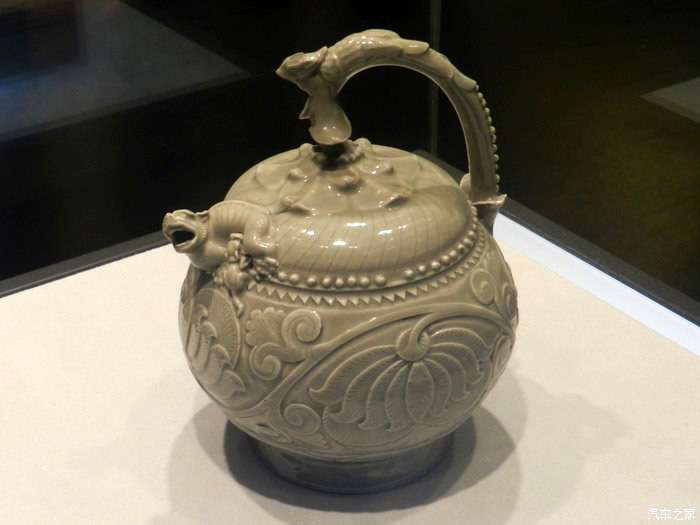 There were government-run porcelain kilns and privately-run kilns. Yaozhou kilns at Tongchan, Shaanxi Province are representative of the celadon vessels in the northern part of China.
There were government-run porcelain kilns and privately-run kilns. Yaozhou kilns at Tongchan, Shaanxi Province are representative of the celadon vessels in the northern part of China.
The most famous porcelain shown here is an inverted-flow celadon kettle produced at the Yaozhou kilns during the Northern Song Dynasty. The kettle is beautifully decorated and uniquely shaped. The spout is in the shape of a lioness lying on her back and a suckling lion cub,, displaying high level carving techniques. The transparent olive green glaze makes the vessel prettier. Why is it called an inverted-flow celadon kettle? That’s because there is no lid at the top. The opening is at the centre of the vessel’s bottom. The kettle has to be turned upside down to fill it with water, and at this time water will not come out of the sprout. When the kettle is filled with water, it will be turned upright, and the water will normally come out of the sprout, and will not leak from the bottom. This clever design shows the physical principle that ‘the water level in connecting vessels always remains level’.
Location: No.91, Xiaozhai East Road, Southern Xi’an
Opening Time: Dec-Feb: 9:00 to 17:30 (closed on Monday)
Mar-Nov: 8:30 to 18:00 (closed on Monday)
Ticket Price: Free
Visiting Time: one hour and a half5 Days Xian and Luoyang Heritage Tour 8-day Shaanxi Adventure Tour
Copyright © 2019 Lily Sun China Tours International, Inc. Terms &conditions | Privacy Policy | Sitemap